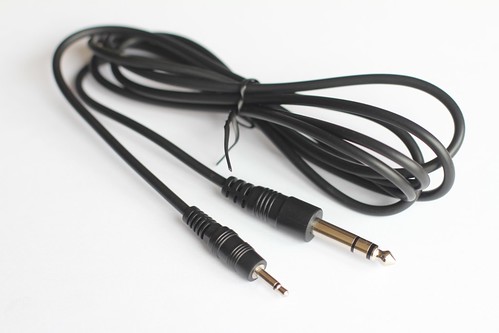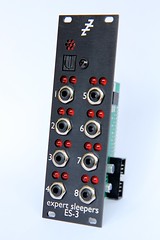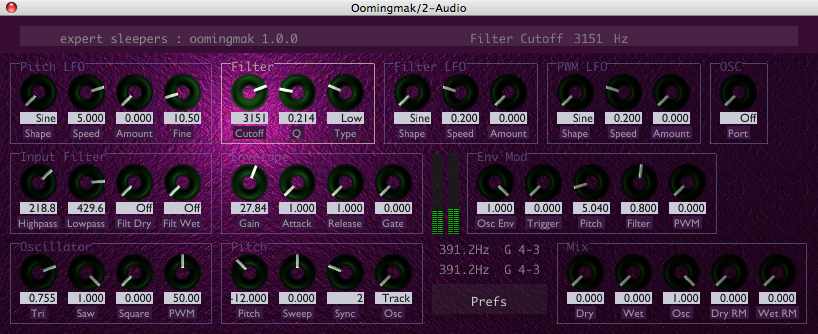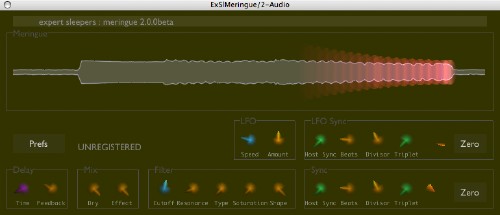Silent Way v2.3.0 released
New in this version:
• Added Silent Way ESX-8CV Combiner.
• Added polyphonic MIDI splitting to Silent Way ES-4 Controller and Silent Way ES-5 Controller.
• Added ESX-8CV mode to Silent Way Voice Controller.
• Fixed a bug which was causing glitches in the paraphonic envelope outputs of Silent Way Voice Controller in poly master mode.
Download now from the downloads page.
Expert Sleepers workshop at London Modular
We videoed it, but sadly this is a single static camera pointed at the presenter - no close-up view of the modular or screencast from the laptop. Still, if you want a general spoken overview of the Expert Sleepers software and hardware, as a change from reading specs or reviews, you could do worse than watch some of this.
Part 1 covers most aspects of the Silent Way software that do not specifically require Expert Sleepers hardware. A MOTU Ultralite audio interface is used to drive the modular for all the demos in this video.
Part 2 moves on to cover the Expert Sleepers hardware.
Little Spacey v1.1.0 (Mac OS X AAX) released
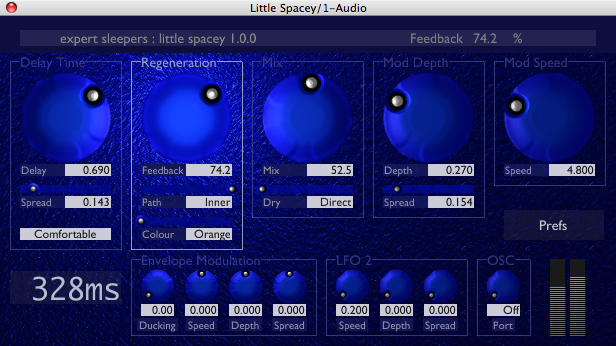
Augustus Loop v2.4.1 released - now AAX
* first AAX release (Mac OS X and Windows, for Pro Tools 10.3.6 & 11)
* fixed the skinning system, which was broken by v2.4.0.
Download now from the downloads page.
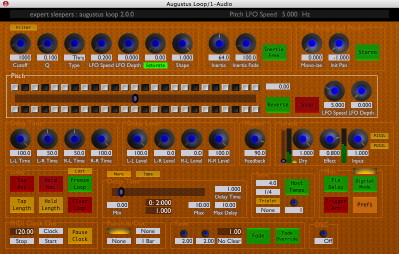
Silent Way v2.2.3 (Windows AAX) released
Download now from the downloads page.
Announcing the ES-3 mk3
The ES-3 is now at mk3. Functionally equivalent to the ES-3 mk2, the mk3 adds these improvements:
* Higher spec DACs and lower noise circuitry
* Easier access to the expansion headers
* More robust ADAT port
* More visible LEDs
Pricing is unchanged.
Crossfade Loop Synth v3.2.3 (AU) released
Download now from the downloads page.
Silent Way v2.2.2 (Mac OS X AU & VST) released
Oomingmak v1.1.1 (Mac OS X AU & VST) released
Little Spacey and Meringue OS X VST now 64 bit
Silent Way v2.2.1 (Mac OS X AAX) released
Augustus Loop v2.4.0 (Windows) released
Download now from the downloads page.

Glow-in-the-dark patch cables back in stock
Little Spacey v1.1.0 released - 64 bit AU
Meringue v2.1.0 released - 64 bit AU
Silent Way Voice Controller Rack Extension released
Silent Way Voice Controller allows you to control your analog synths directly from Reason, in conjunction with a DC-coupled audio interface or an Expert Sleepers hardware module. Think of it as a MIDI/CV converter on steroids - but one that is sample accurate, free of jitter, and which automatically calibrates for perfect tuning. The Voice Controller is the first element of the renowned Silent Way suite to become a Rack Extension. Look out for others joining it soon!
Available now from the Propellerheads Shop.


Silent Way Rack Extension coming soon
Silent Way Rack Extension Teaser on Vimeo.
Silent Way Voice Controller, part of the Silent Way plug-in suite, will soon be available as a Rack Extension for Propellerhead Reason.Silent Way offers deep control over analog synthesizers direct from your DAW.
Expert Sleepers Workshop at Rough Trade East
We videoed it, but sadly this is a single static camera pointed at the presenter - no view of the modular or screencast from the laptop. Still, if you want a general spoken overview of the Expert Sleepers software and hardware, as a change from reading specs or reviews, you could do worse than watch some of this.
Part 1. Subjects covered include:
- Basic software usage with a DC-coupled interface.
- Use of the ES-3 for audio.
- Use of the Voice Controller plug-in with the ES-3 module.
- Silent Way LFO and Step LFO plug-ins.
- Silent Way Quantizer & calibration files.
Part 2. Subjects covered include:
- The expander modules (ES-5, ESX-8GT, ESX-4CV).
- Using the expanders to trigger drum modules.
- Silent Way Sync.
- The input modules (ES-6 & 7).
- Recording and processing CVs in the computer.
- Polyphony.
- Max/MSP externals.
Max/MSP externals now available
Download now from the downloads page.
Silent Way now available as Windows AAX
Download now from the downloads page.
XFadeLooperCM feature in Computer Music
The feature also includes a (heavily edited!) interview with your truly. For the record, here’s the full text that I submitted:
- what inspired Crossfade Loop Synth?
Back in 2002, I was transitioning my mostly hardware studio setup to a more software-based one (something I've since mostly reversed - but that's another story). Time-stretching & granular resynthesis was all the rage at the time - things the new-fangled software instruments could do which traditional hardware generally couldn't. As a result, finding a sampler instrument that actually did work like an old hardware unit seemed surprisingly hard.
At the same time, Apple had not long released Mac OS X, and with it Project Builder (which later became Xcode). Previously, software development on Macs involved buying a development environment; now it was available for free. So there was no longer a reason not to dabble.
So, to satisfy my own musical needs, and enabled by the new software ecosystem of OS X, I decided to have a crack at writing a plug-in.
The result, Crossfade Loop Synth 0.1b, was released in December 2002.
- what challenges were involved in its creation?
Despite being a reasonably experienced developer at the time, I'd never before worked on a Mac, so that was all new. Also, for reasons that aren't completely clear in retrospect, I decided to do it as an Audio Unit (buying the whole Apple shebang hook line & sinker, I guess), and the AU SDK was very immature at the time. Fortunately some AU pioneers had put their work up online so I was able to learn from example.
Crossfade Loop Synth v2 (2004) was the second (I think?) plug-in of mine to use my new graphical UI framework, originally created for my additive synthesis instrument Minky Starshine. There was still lots of learning going on at that time.
Crossfade Loop Synth v3 (2007) was the real challenge. Applying analogue VCO concepts like pulse width modulation and hard sync to sampled material was great fun, if your idea of fun involves lots of hard work and head-scratching. And the effect version - being able to record into the sample buffer while playing notes (at any speed, in either/both directions) - was the real head-f***.
- what do you think of other software samplers?
The only one I've ever used much is VSamp (http://www.vsamp.com). That's what I use if I want a traditional multi-sample of something vaguely realistic - it comes with a nice free library of orchestral staples. I mean, it's a tiny tiny thing compared to modern multi-GB romplers, but it works well for what I do. Otherwise, I just use Crossfade Loop Synth. Or a Live drum rack I guess would be the only other time I use a sample instrument.
It strikes me that there's very little emphasis on actual sampling in modern instruments. Just on playing samples back.
- do you have a favourite hardware sampler?
Roland S-330. A fantastic bit of kit - I used one for years back in the 90s. Its 'alternating' loop mode was the inspiration for the feature of the same name in Crossfade Loop Synth v2, and really the reason I wanted to create a sampler instrument in the first place. I used that all the time. It really was a unique thing at the time - a 1U rack box but you could plug in a mouse and a monitor, and see your stuff up on a screen. No editing through a tiny LCD window on the box itself. Really revolutionary.
- do you have any tips for readers using the instrument?
Buy the full version! :)
Do try the 'alternating' loop mode, especially on pads.
If you have a volume dip at the loop point, try the different Crossfade Types (Equal Gain/Equal Power).
Go nuts with Hard Sync.
Overall - the sample is just fodder for the instrument to create sound from. Don't just play it back, pure and simple. See what else you can make with it!
Silent Way v2.2.0 released
• Added Silent Way Logic Project.
• Added controls for Interface Categories.
• Silent Way Step LFO can now be reset and/or triggered by MIDI notes and/or incoming CVs.
• Added ‘Gate Length’ control to Silent Way Step LFO.
• Added ‘Random’ feature to Silent Way Step LFO.
• Silent Way CV To MIDI, VST version, can now output MIDI direct to the host.
• Silent Way CV To MIDI can now output MIDI directly to Silent Way Learner.
• Silent Way Learner now supports MIDI polyphonic pressure messages.
• Added ‘SMUX Proof’ mode for Silent Way ESX-4CV Combiner.
• Fixed Silent Way Learner, VST and AU versions, to correctly output silence.
Download now from the downloads page.
Silent Way Step LFO new features in v2.2.0 on Vimeo.
Ping Pong Delay v2.0.9 released
You won’t have seen Ping Pong Delay mentioned here for some time. It’s a free (as in beer) delay plug-in.
Silent Way v2 reviewed in Future Music
If you're looking to control CV-equipped analogue hardware from the comfort of your DAW, we can't recommend it highly enough.
ES-7 CV To MIDI demo
New modules - ES-6 & ES-7
The ES-6 is the counterpart to the ES-3 Lightpipe/CV Interface, offering up to 8 channels of CV input with output via an optical lightpipe connection.
The ES-7 provides two channels of DC-coupled CV input to a connected ES-4 or ES-6 module.
Both are available now.
Silent Way v2.1.0 released
* Added a new plug-in: Silent Way Function. SW Function applies simple mathematical operations to incoming CVs. It is intended to be particularly useful in conjunction with the forthcoming ES-6 and ES-7 modules.
* Added "Calibrated" mode to Silent Way Follower, allowing it to use calibration profiles generated in SW Voice Controller, for accurate pitch tracking from incoming audio to your analogue VCOs.
* Added "Transport2" sync mode to Silent Way LFO. Like the existing Transport mode, but stops when the host transport stops.
* Added a “Transfer” button to Silent Way Soundplane and Silent Way Follower, allowing one click transfer of a calibration from Voice Controller to another plug-in that uses is, without having to save the calibration to disk and load it back in.
* Added support for the Expert Sleepers ES-5 module to Silent Way Sync.
* Added sustain pedal support to Silent Way Voice Controller.
* Fixed a bug that would cause Silent Way Follower to lock up the host application.
Download now from the downloads page.
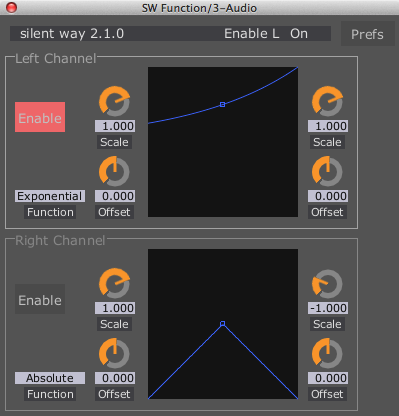
'Floating ring' cables now available
Buy direct here, or soon from your local reseller.
